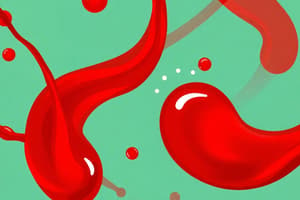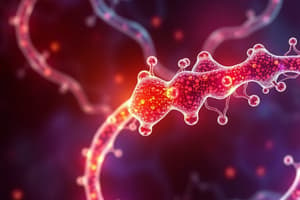Podcast
Questions and Answers
What term describes a state of normal blood glucose levels, which is the target for diabetes management?
What term describes a state of normal blood glucose levels, which is the target for diabetes management?
- Euglycemia (correct)
- Glucogenesis
- Hyperglycemia
- Hypoglycemia
Hypoglycemia is defined as a fasting blood glucose level greater than 100 mg/dL.
Hypoglycemia is defined as a fasting blood glucose level greater than 100 mg/dL.
False (B)
List three common symptoms of hypoglycemia.
List three common symptoms of hypoglycemia.
Weakness, dizziness, headache.
A long-term consequence of hyperglycemia that affects the eyes is known as ________.
A long-term consequence of hyperglycemia that affects the eyes is known as ________.
Match the following blood glucose levels with their corresponding conditions:
Match the following blood glucose levels with their corresponding conditions:
Which of the following is a short-term consequence of hyperglycemia?
Which of the following is a short-term consequence of hyperglycemia?
Type 1 diabetes is primarily managed through lifestyle modifications and oral hypoglycemic agents.
Type 1 diabetes is primarily managed through lifestyle modifications and oral hypoglycemic agents.
Provide two examples of fast-acting carbohydrates that can be used to treat hypoglycemia.
Provide two examples of fast-acting carbohydrates that can be used to treat hypoglycemia.
The goal for HbA1c (glycated hemoglobin) in individuals with diabetes is typically less than ______ percent.
The goal for HbA1c (glycated hemoglobin) in individuals with diabetes is typically less than ______ percent.
Match the following dietary recommendations with their benefits in managing blood glucose levels:
Match the following dietary recommendations with their benefits in managing blood glucose levels:
Which microvascular complication of diabetes is a leading cause of blindness?
Which microvascular complication of diabetes is a leading cause of blindness?
Primary prevention strategies for impaired glucose regulation focus on managing existing diabetes rather than preventing its onset.
Primary prevention strategies for impaired glucose regulation focus on managing existing diabetes rather than preventing its onset.
Name two classes of oral hypoglycemic agents used in the pharmacological management of type 2 diabetes.
Name two classes of oral hypoglycemic agents used in the pharmacological management of type 2 diabetes.
________ is a non-pharmacological intervention that involves regular exercise to improve insulin sensitivity and aid in weight management.
________ is a non-pharmacological intervention that involves regular exercise to improve insulin sensitivity and aid in weight management.
Match the counter-regulatory hormones with their primary effects on glucose regulation:
Match the counter-regulatory hormones with their primary effects on glucose regulation:
Which hormone, released by the adrenal medulla, stimulates glycogenolysis and gluconeogenesis, leading to increased blood glucose levels?
Which hormone, released by the adrenal medulla, stimulates glycogenolysis and gluconeogenesis, leading to increased blood glucose levels?
ACE inhibitors generally increase blood glucose levels.
ACE inhibitors generally increase blood glucose levels.
Name two classes of non-diabetic medications that can increase blood glucose levels.
Name two classes of non-diabetic medications that can increase blood glucose levels.
Chronic elevation of ________, such as in Cushing’s syndrome or prolonged steroid therapy, can contribute to hyperglycemia and insulin resistance.
Chronic elevation of ________, such as in Cushing’s syndrome or prolonged steroid therapy, can contribute to hyperglycemia and insulin resistance.
Match the following symptoms to either hyperglycemia or hypoglycemia:
Match the following symptoms to either hyperglycemia or hypoglycemia:
What is the primary etiology of type 1 diabetes?
What is the primary etiology of type 1 diabetes?
Diaphoresis is a common symptom of hyperglycemia.
Diaphoresis is a common symptom of hyperglycemia.
List three long-term consequences of chronic hyperglycemia.
List three long-term consequences of chronic hyperglycemia.
Consuming ________ is recommended for managing hypoglycemia as it provides fast-acting carbohydrates.
Consuming ________ is recommended for managing hypoglycemia as it provides fast-acting carbohydrates.
Match the glucose regulation terms with their numerical definitions:
Match the glucose regulation terms with their numerical definitions:
Which of the following is a goal of secondary prevention related to glucose regulation?
Which of the following is a goal of secondary prevention related to glucose regulation?
Weight management is more critical in type 1 diabetes than in type 2 diabetes for glucose regulation.
Weight management is more critical in type 1 diabetes than in type 2 diabetes for glucose regulation.
Describe two benefits of exercise for individuals at risk of or with impaired glucose regulation.
Describe two benefits of exercise for individuals at risk of or with impaired glucose regulation.
________ is defined as a state of insufficient or low blood glucose levels.
________ is defined as a state of insufficient or low blood glucose levels.
Match the following diabetes-related complications with their descriptions:
Match the following diabetes-related complications with their descriptions:
Which of the following best describes the action of glucagon?
Which of the following best describes the action of glucagon?
Calcineurin inhibitors typically lower blood glucose levels.
Calcineurin inhibitors typically lower blood glucose levels.
What immediate action should a nurse take if a client with diabetes becomes unconscious due to severe hypoglycemia?
What immediate action should a nurse take if a client with diabetes becomes unconscious due to severe hypoglycemia?
________, secreted by the anterior pituitary, increases lipolysis and reduces glucose uptake in muscle and adipose tissue.
________, secreted by the anterior pituitary, increases lipolysis and reduces glucose uptake in muscle and adipose tissue.
Match the following consequences with the condition they are associated with:
Match the following consequences with the condition they are associated with:
A patient with Cushing's syndrome is at risk for hyperglycemia due to the chronic elevation of which hormone?
A patient with Cushing's syndrome is at risk for hyperglycemia due to the chronic elevation of which hormone?
Self-monitoring of blood glucose is less important for patients with type 2 diabetes compared to type 1 diabetes.
Self-monitoring of blood glucose is less important for patients with type 2 diabetes compared to type 1 diabetes.
Identify two lifestyle modifications that can help manage type 2 diabetes.
Identify two lifestyle modifications that can help manage type 2 diabetes.
The risk of _________ is increased because high blood glucose impairs immune function.
The risk of _________ is increased because high blood glucose impairs immune function.
Match the non-pharmacological interventions with their descriptions
Match the non-pharmacological interventions with their descriptions
Which factor distinguishes type 1 from type 2 diabetes in terms of etiology and typical onset?
Which factor distinguishes type 1 from type 2 diabetes in terms of etiology and typical onset?
Flashcards
Glucose Regulation
Glucose Regulation
Maintaining stable blood glucose levels within a normal range.
Euglycemia
Euglycemia
Normal blood glucose levels, the target for healthy individuals and diabetes management.
Hypoglycemia
Hypoglycemia
Insufficient or low blood glucose levels, typically less than 70 mg/dL fasting or 99 mg/dL 2-hours postprandial.
Hyperglycemia
Hyperglycemia
Signup and view all the flashcards
Population Risk Factors
Population Risk Factors
Signup and view all the flashcards
Individual Risk Factors
Individual Risk Factors
Signup and view all the flashcards
Symptoms of Hypoglycemia
Symptoms of Hypoglycemia
Signup and view all the flashcards
Symptoms of Hyperglycemia
Symptoms of Hyperglycemia
Signup and view all the flashcards
Short-Term Effects of Hyperglycemia
Short-Term Effects of Hyperglycemia
Signup and view all the flashcards
Long-Term Effects of Hyperglycemia
Long-Term Effects of Hyperglycemia
Signup and view all the flashcards
Short-Term Effects of Hypoglycemia
Short-Term Effects of Hypoglycemia
Signup and view all the flashcards
Long-Term Effects of Hypoglycemia
Long-Term Effects of Hypoglycemia
Signup and view all the flashcards
Type 1 Diabetes (T1D)
Type 1 Diabetes (T1D)
Signup and view all the flashcards
Type 2 Diabetes (T2D)
Type 2 Diabetes (T2D)
Signup and view all the flashcards
Hyperglycemia Symptoms
Hyperglycemia Symptoms
Signup and view all the flashcards
Hyperglycemia Management
Hyperglycemia Management
Signup and view all the flashcards
Hypoglycemia Symptoms
Hypoglycemia Symptoms
Signup and view all the flashcards
Hypoglycemia Management
Hypoglycemia Management
Signup and view all the flashcards
Fast-Acting Carbohydrates
Fast-Acting Carbohydrates
Signup and view all the flashcards
Fasting Blood Glucose Goal
Fasting Blood Glucose Goal
Signup and view all the flashcards
Postprandial Blood Glucose Goal
Postprandial Blood Glucose Goal
Signup and view all the flashcards
HbA1c Goal
HbA1c Goal
Signup and view all the flashcards
Carbohydrate Counting
Carbohydrate Counting
Signup and view all the flashcards
Balanced Diet
Balanced Diet
Signup and view all the flashcards
Benefits of Exercise
Benefits of Exercise
Signup and view all the flashcards
Exercise Recommendations
Exercise Recommendations
Signup and view all the flashcards
Weight Management Goal
Weight Management Goal
Signup and view all the flashcards
Microvascular Complications
Microvascular Complications
Signup and view all the flashcards
Macrovascular Complications
Macrovascular Complications
Signup and view all the flashcards
Primary Prevention Goals
Primary Prevention Goals
Signup and view all the flashcards
Secondary Prevention
Secondary Prevention
Signup and view all the flashcards
Goal of primary prevention
Goal of primary prevention
Signup and view all the flashcards
Pharmacological Interventions
Pharmacological Interventions
Signup and view all the flashcards
Non-Pharmacological Interventions
Non-Pharmacological Interventions
Signup and view all the flashcards
Nursing Responsibilities
Nursing Responsibilities
Signup and view all the flashcards
Counter-Regulatory Hormones
Counter-Regulatory Hormones
Signup and view all the flashcards
Glucagon
Glucagon
Signup and view all the flashcards
Epinephrine (Adrenaline)
Epinephrine (Adrenaline)
Signup and view all the flashcards
Cortisol
Cortisol
Signup and view all the flashcards
Study Notes
- Glucose regulation refers to maintaining blood glucose levels within a normal range.
Glucose Regulation Definitions
- Euglycemia is a state of normal blood glucose levels, seen in healthy individuals and the target for diabetes management.
- Hypoglycemia is a state of low blood glucose levels, less than 70 mg/dL when fasting or 99 mg/dL 2 hours after eating.
- Hyperglycemia is a state of elevated blood glucose levels, more than 100 mg/dL when fasting or 140 mg/dL 2 hours after eating.
Risk Factors for Impaired Glucose Regulation
- Population factors:
- Age
- Pregnancy
- Specific racial and ethnic groups
- Individual factors:
- Genetics and family history
- Lifestyle
- Selected medications
- Underlying metabolic issues, mainly involving insulin resistance and impaired insulin secretion
Recognizing Compromised Glucose Regulation
- Hypoglycemia signs and symptoms:
- Weakness
- Dizziness
- Headache
- Hunger
- Blurred vision
- Difficulty concentrating
- Feeling shaky
- Palpitations
- Hyperglycemia signs and symptoms:
- Nausea
- Vomiting
- Abdominal cramps
- Fatigue
- Excessive hunger (polyphagia)
- Excessive thirst (polydipsia)
- Symptoms may be associated with dehydration or acidosis
Short-Term Consequences
- Hyperglycemia:
- Increased thirst and urination
- Fatigue
- Blurred vision
- Headaches
- Slow wound healing
- Irritability and difficulty concentrating
- Nausea and vomiting
- Hypoglycemia:
- Diaphoresis
- Nervousness
- Irritability
- Shaking
- Rapid heartbeat
- Hunger
- Confusion
- Difficulty concentrating
- Dizziness
- Blurred vision
- Severe: Loss of consciousness or seizures
Long-Term Consequences
- Hyperglycemia:
- Cardiovascular complications
- Neuropathy
- Nephropathy
- Retinopathy
- Poor wound healing and infection
- Cognitive decline and brain health
- Bone and joint problems
- Hypoglycemia:
- Cognitive impairment
- Hypoglycemia unawareness (no longer experiencing typical warning signs)
- Cardiovascular events
- Psychological impact (anxiety, depression)
- Reduced ability to function
- Potential for organ damage
- Death
Relevant Labs
- Hypoglycemia:
- BG 180 mg/dL
Nursing and Collaborative Interventions
- Client teaching should include diabetes type I & II, Hyper- & Hypoglycemia, goals for test results, lifestyle (nutrition (diet), exercise, weight control), consequences of chronic hyperglycemia & impaired glucose regulation.
Diabetes Types Overview
- Type 1 Diabetes (T1D): An autoimmune condition, leads to destruction of insulin-producing beta cells in the pancreas, requires lifelong insulin therapy.
- Type 2 Diabetes (T2D): Characterized by insulin resistance and eventual beta-cell dysfunction, managed with lifestyle changes, oral hypoglycemic agents, and sometimes insulin.
Hyperglycemia and Hypoglycemia Education
- Hyperglycemia:
- Signs and symptoms include increased thirst (polydipsia), frequent urination (polyuria), blurred vision, and fatigue
- Managed by adjusting insulin doses, monitoring blood glucose regularly, maintaining hydration, and engaging in physical activity as appropriate
- Hypoglycemia:
- Signs and symptoms include shakiness, sweating, confusion, irritability, dizziness, and headache
- Managed by consuming fast-acting carbohydrates, monitoring blood glucose levels, and carrying quick-acting glucose sources
- 4-6 oz regular soda or orange juice
- 5-8 Lifesavers
- 1 tbsp honey or syrup
- 4 tsp jelly
- 1 package dextrose
- Unconscious: 1 mg glucagon subcutaneous/IM or 20-150 mL of 10% glucose IV
- Turn client on side to prevent aspiration
Goals for Test Results
- Blood Glucose Monitoring:
- Fasting blood glucose: Generally 70-99 mg/dL
- Postprandial blood glucose: Generally 100-139 mg/dL
- Continuous monitoring: Regular self-monitoring helps adjust therapy and understand personal glycemic patterns
- HbA1c (Glycated Hemoglobin):
- Goal: Typically less than 7%, which reflects average blood glucose over the past 3 months
- Importance: Achieving this target reduces the risk of diabetes-related complications
Lifestyle Modifications
- Nutrition (Diet):
- Carbohydrate counting: Essential for insulin dose adjustments, especially in T1D
- Balanced diet: Emphasize vegetables, lean proteins, healthy fats, and whole grains; limit processed foods and sugars
- Meal timing: Regular meals and snacks help maintain stable blood glucose levels
- Exercise:
- Benefits: Improves insulin sensitivity, helps in weight management, and supports cardiovascular health
- Recommendations: At least 150 minutes of moderate-intensity aerobic activity per week, along with strength training
- Precautions: Monitor blood glucose before, during, and after exercise to prevent hypoglycemia; carry glucose sources during physical activity
- Weight Management:
- Goal: Achieve and maintain a healthy weight to enhance insulin sensitivity and reduce T2D risk
- Strategies: Combine dietary modifications with regular physical activity
- Support: Collaborate with healthcare providers to set realistic weight loss goals and monitor progress
Consequences of Chronic Hypoglycemia and Impaired Glucose Regulation
- Microvascular Complications:
- Retinopathy: Leading cause of blindness; regular eye exams are crucial
- Nephropathy: Can progress to kidney failure; monitor kidney function regularly
- Neuropathy: May result in foot ulcers and amputations; daily foot inspections are recommended
- Macrovascular Complications:
- Cardiovascular disease: Increased risk of heart disease and stroke; manage blood pressure and cholesterol levels
- Other Considerations:
- Infections: High blood glucose impairs immune function, increasing infection risk
- Wound healing: Delayed healing due to poor glycemic control
Primary and Secondary Prevention
- Primary Prevention:
- Goal: Healthy lifestyle behaviors
- Optimal body weight
- Regular physical activity
- Healthy balanced diet
- Goal: Healthy lifestyle behaviors
- Secondary Prevention (Screening):
- Blood glucose screen in high-risk individuals
Pharmacological vs. Non-Pharmacological Interventions
- Pharmacological Interventions:
- Insulin therapy
- Oral hypoglycemic agents
- Biguanides
- Sulfonylureas
- Meglitinides
- Non-Pharmacological Interventions:
- Nutrition therapy:
- Whole grains
- Lean proteins
- Healthy fats
- Fiber-rich foods
- Physical activity:
- Regular exercise
- Weight management:
- Weight loss (type 2)
- Self-Monitoring of Blood Glucose (SMBG)
- Stress management
- Nutrition therapy:
Collaborative Interventions
- Engaging a multidisciplinary team
- Nursing Responsibilities:
- Monitoring blood glucose levels
- Educating patients
- Assessing for complications
Effects of Counter-Regulatory Hormones on Glucose Regulation
- Glucagon:
- Source: Secreted by alpha cells of the pancreas
- Effect:
- Stimulates hepatic glycogenolysis (breakdown of glycogen into glucose)
- Promotes gluconeogenesis (glucose synthesis from non-carbohydrate sources)
- Increases ketogenesis when glucose availability is low
- Clinical Implication: Used as an injectable treatment for severe hypoglycemia
- Epinephrine (Adrenaline):
- Source: Released by the adrenal medulla in response to stress, hypoglycemia, or exercise
- Effect:
- Stimulates glycogenolysis and gluconeogenesis
- Inhibits insulin release
- Increases lipolysis, providing alternative energy sources
- Clinical Implications: High levels during stress or illness can lead to hyperglycemia
- Cortisol:
- Source: Secreted by the adrenal cortex in response to stress (HPA axis activation)
- Effect:
- Promotes hepatic gluconeogenesis
- Induces insulin resistance in peripheral tissues
- Mobilizes amino acids and fats for glucose production
- Clinical Implication: Chronic cortisol elevation (e.g., Cushing’s syndrome, prolonged stress, or steroid therapy) contributes to hyperglycemia and insulin resistance
- Growth Hormone (GH):
- Source: Secreted by the anterior pituitary
- Effect:
- Increases lipolysis and fatty acid utilization
- Reduces glucose uptake in muscle and adipose tissue
- Enhances hepatic glucose production
- Clinical Implication: Excess GH (e.g., acromegaly) is associated with insulin resistance and hyperglycemia
Non-Diabetic Medications Affecting Glucose Regulation
- Medications that Increase Blood Glucose (Hyperglycemic Effects):
- Glucocorticoids
- Thiazide diuretics
- Atypical antipsychotics
- Oral contraceptives
- Calcineurin inhibitors
- Medications that Lower Blood Glucose (Hypoglycemic Effects):
- ACE inhibitors
- Beta blockers
- Salicylates (high dose)
- Ethanol (alcohol)
Studying That Suits You
Use AI to generate personalized quizzes and flashcards to suit your learning preferences.



